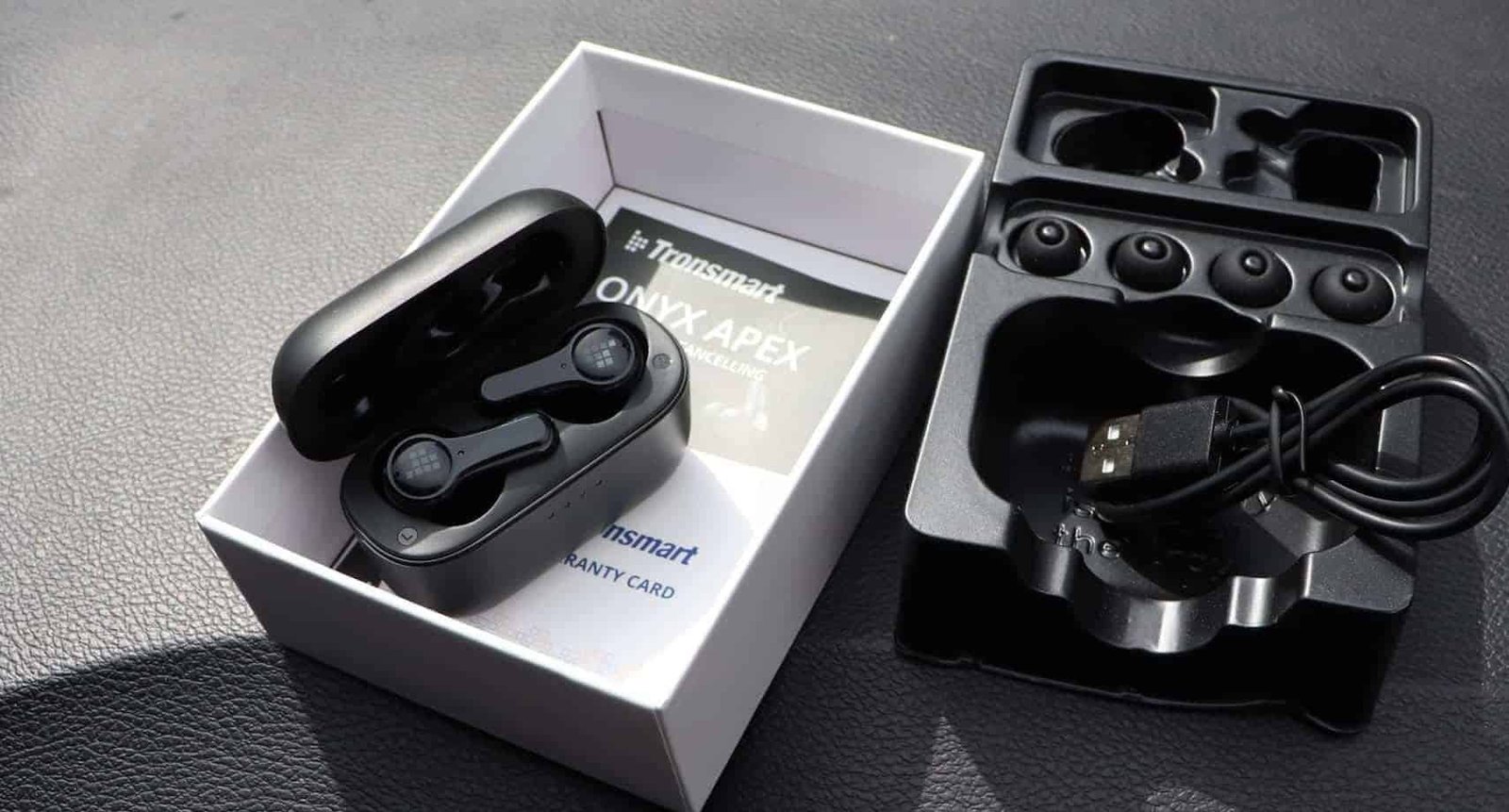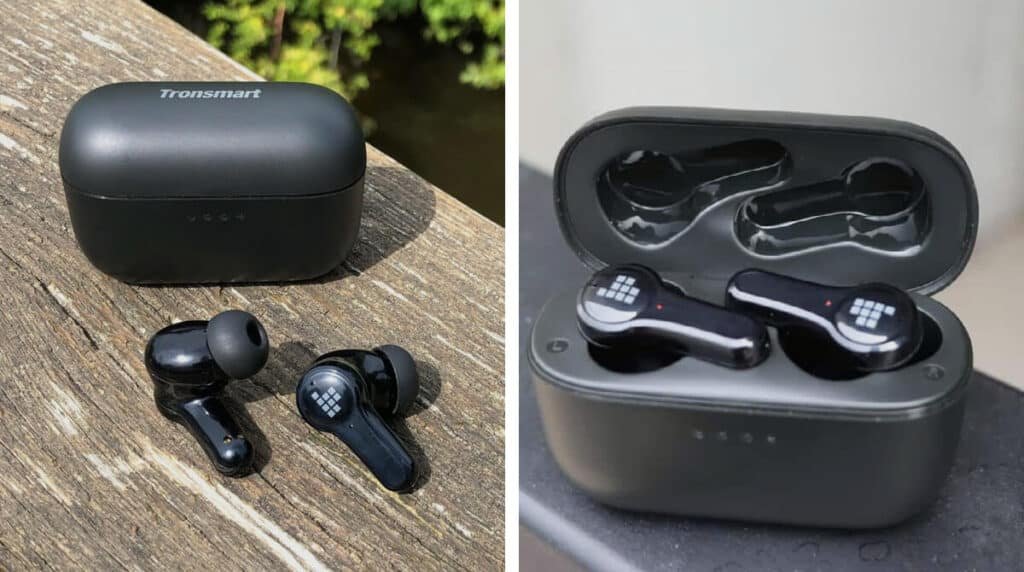The Tronsmart Onyx Apex are inexpensive TWS headphones with ANC. In addition, they are very comfortable, the sound is quality, and the hands-free is excellent. They also allow you to control everything from the touch buttons and are resistant to sweat and splashes.

Thanks to that, their value for money is spectacular, they are the best mid-range headphones of the moment. Of course, keep in mind that they dispense with some advanced functions such as wireless charging of the box or automatic ear detection.
| PROS | CONS |
| Comfortable and light | No wireless charging |
| Good active noise cancellation | |
| Good sound quality |
General
| Tronsmart Onyx Apex Earbuds | |
| Brand | Tronsmart |
| Type | True wireless |
| Colors | Black |
| Chip | Qualcomm QCC3040 |
| Weight | 50g |
| Dimension | 63 x 30.1 x 41.85mm |
| Connectivity | Wireless |
The headphones, they do feel quite well built and have the same quality and material feel as the Apollo Airs. Each earbud weighs about 5 grams, and the two earbuds together with the case weigh 47 grams.

The case is relatively compact and has rounded curves so that it can be easily carried in your trouser pocket.
The part placed in the ear has an oval shape that fits with a slight twist, and thus, the part that goes into the ear is relatively short. The rubber tips used by the Onyx Apex are faster and stockier than average in-ear headphones; they are similar in height to those of the AirPods Pro. That, together with the temple, makes the weight of the headphones very well distributed. Thanks to that, they are one of the most comfortable headphones, and, in addition, they do not move me running.
Design
| Type | In-Ear |
| Wireless | Yes |
| Noise Cancelling | Yes |
| Frequency range | Up to 10m/32.8ft |
| Impedance | 10Ω |
| Voice assistant | Google Assistant, Siri |
The Tronsmart Onyx Apex is TWS in-ear headphones (the kind that goes into the ear), but they also have a small pin on each earphone.
The design of the headphones is similar to that of the Tronsmart Apollo Air. However, the Onyx Apex (on the right of the photo) has a smaller temple, and the part placed in the ear is somewhat less bulky.

And, since the Apollo Airs are very comfortable and adapt well to all ear and ear sizes, thanks to their shapes, the Onyx Apex is just as or even more comfortable.
Both the headphones and the case are made of plastic with good finishes. However, it is noted that the quality of the plastic is somewhat lower in the Onyx Apex, mainly in the case, something understandable due to the lower price. The case has a thinner plastic that looks like it will get scratched more easily than the Apollo Airs. Even so, it has a quality comparable to other TWS headphone boxes in the same price range, and with minimal care, we will keep it as the first day for a long time.

Also, the lid does not stay open. It’s not a big problem for me, but it’s something I prefer to mention because there are people who want the lid to remain open, even if they tilt the headphone box.
Luckily, the Onyx Apex box has 4 LEDs that indicate the battery level clearly and much more conveniently than the single colored LED in the Apollo Airbox.
Features
| Microphone | 4 mics |
| Driver Unit | 10mm |
| Music Controls | Yes |
| App | No |
| Audio codecs | AAC SBC Qualcomm AptX |
| Microphone | Integrated |
| Waterproof | Yes |
On the outside of the headphones, we have a touch zone under the Tronsmart logo. Thanks to these buttons, we can control:
- Turn on: press and hold for 3 seconds
- Power off: press and hold for 5 seconds
- Turn up the volume: one tap on the right earbud
- Volume down: one tap on the left earbud
- Skip to the next song: hold for 2 seconds on the right earbud
- Go back to the previous song: hold for 2 seconds on the left earbud
- Pause or resume playback: two taps on any headset
- Control ANC: three taps on any headset
- Answer or hang up active call: two taps on any headset
- Reject call: press any headset for 2 seconds
- Call the mobile assistant: two taps and hold any headset for one second
As we can see, we can control practically everything with headphones.
Battery
| Battery | Earbuds:35 mAh; Charging Case:400 mAh |
| Battery Life | Up to 24hrs |
| Charge Time | Earbud: About 2 Hours Charging Case: About 2 Hours |
| Charging Port | Type-C Port |
Each headset has an internal battery with a capacity of 35 mAh that provides us with an autonomy of about 6 hours playing music at medium volume with the ANC off. If we turn on the ANC, the autonomy is reduced a little, up to approximately 5 hours.
The box has an internal 400 mAh battery with which we can fully charge the headphones about 4 times. Thanks to this, the total autonomy of the set is around 30 hours with the ANC off and about 25 hours with the ANC on.
Connectivity
| Bluetooth | Yes 5.2 v |
| Bluetooth profile | HFP/HSP/AVRCP/A2DP |
The headphones mount Bluetooth 5.2 and the Qualcomm QCC3040 chip. The connection is entirely stable, and besides that, the headphones are compatible with SBC, AAC, and aptX codecs. The QCC3040 chip supports aptX Adaptive codecs, but headphones are not supported.

The latency is relatively low, the sound and the image are completely synchronized. In fast games, such as shooting games, we can notice a slight delay in the sound, although they cannot play casual games without too many problems.
Of course, the headphones work in dual-host mode, and we can use one or both headphones simultaneously without having to configure anything on the mobile and without stopping the playback. Of course, here, there is no automatic pairing when we open the lid, so you have to take them from the box to start the pairing.
Each earphone mounts a 10mm dynamic driver, a generously sized driver for in-ear headphones.
The sound is equalized in a V shape with a bit of bass dominance. Bass’s performance is very similar to the Apollo Air. The subwoofers are profound, but they seem faster than the Apollo Air, softer and more relaxed.
The mids are more transparent and direct than those of the Apollo Air, which are warmer and more relaxed. The result is that the lead instruments and vocals sound somewhat more prominent and lively.
The same goes for the highs; the Onyx Apex has more highs, making the sound a bit more appealing than the more relaxed highs of the Apollo Air.
In general, the sound has a predominant bass, but with mids and highs that do not get off the hook. Compared to the Apollo Airs, the Onyx Apex have a more dynamic sound, and the Apollo Airs are more relaxed and listening for a long time.
The earbuds have pretty good passive isolation at the level of the AirPods Pro. However, the Apollo Air blocks a bit more due to the more profound fit style. As for the ANC, it has acceptable performance, although it is nothing to write home about. It reduces noise from PC fans and street traffic quite well, although not to typical Bose or Sony levels. But for the price they have, the ANC is very well done.
Of course, they have several modes of operation: ANC mode on, room mode, and ANC mode off. Ambient mode sounds acceptable, although some noises are too loud and not entirely natural. Of course, the voices sound pretty straightforward, and we can carry on a conversation with ease.
Each headset mounts two microphones with CVC 8.0 technology, something common in this class of headphones. The CVC allows us to improve the sound quality of our voice during calls while minimizing ambient noise. But the important thing is that the microphones of the Onyx Apex are of excellent quality and pick up our voice with force and clarity. Thanks to that, they are some of the best hands-free headphones I’ve ever tried. People say they don’t notice that I’m using the hands-free and that the voice is loud, clear, and entirely natural.
Conclusion!
The Onyx Apex is one of the complete mid-range headphones. In general, the sound is of excellent quality, with powerful bass and good treble. Also, the hands-free is excellent, and the headphones are very comfortable.
Considering all that and that the Onyx Apex have ANC, their closest rival is the regular Tronsmart Apollo Air, not the Air +. They cost a bit more, and the ANC is a bit better. In addition, by going deeper into the ear, its passive noise cancellation is also better. However, if you don’t like headphones to be too deep in your ear, the Onyx Apex will be the best option for you.


